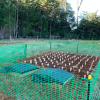
Understand how trees improve the carbon balance - carbon investing improves your ROI from trees
Posted 19 June 2020
Managing trees Economic benefits and markets Carbon benefits
Many private landowners have expressed a strong interest in using trees to reduce climate impacts by sequestering more carbon.
Co-incidentally this carbon investment will increase the economic return from trees on farms which adds to a myriad of other benefits.
Private Forest Tasmania have been negotiating with various carbon investors and as a result developed relationships with a number of these including; Corporate Carbon Advisory/Climate Friendly, WeAct and Greenfleet.
These investors have stated their willingness to work with tree growers in Tasmania although Private Forest Tasmania will continue to seek others and will post their credentials in due course.
Planting commercially viable trees is a good way to improve the carbon balance because the harvested product is usually locked up in timber and other fibrous materials on a permanent basis. There are two ways to address rising atmospheric CO2: reducing emissions and absorbing and storing CO2.
Trees and wood products can do both. When trees grow, they actively absorb carbon from the atmosphere and store it as wood.
When wood from sustainably managed sources is used in place of other materials such as metal, concrete and plastic, that return more CO2 to the atmosphere over their lifecycle, there are also carbon emission reduction benefits. The trees can then be replanted, and the cycle starts again.
Apart from these climate benefits, as a tree grower you can obtain significant assistance in the form of a rebate via the Federal Government’s Emissions Reduction Fund (ERF).
To access this you are often best served by working with a professional organisation such as those listed above.
These organisations are equipped to manage the mapping and accounting necessary to satisfy the regulators.
Share this Article
Latest Articles
-

17 September 2025
Celebrating excellence at the Tasmanian Timber Awards
-

17 September 2025
Forest Practices Authority Research Update Day
-

13 August 2025
Have you seen our Stems for CO2 Project signage on the Midlands Highway?
Archives
- ActivAcre hits milestone, calls for more farmers to get on board
- Napier's leading the way in sustainable forestry and carbon-neutral farming
- Sound science needed to assess carbon impacts of timber harvesting
- Newly appointed TFFPN Board of Directors
- Graduate Certificate of Forestry Scholarship
- Forestry Australia Mentoring Program 2025
- Forest Industry Roundtable planning for the long term
- Eagle Management Constraint Period extended
- Successful private native forest management celebrated
- $15 million investment in new ship loader to boost Bell Bay's forestry exports
- Standing with Tasmania's forestry industry: buy local
- TFPA: Tasmanian Freight Equalisation Scheme needs a ground-up review
- AFCA Gala Dinner celebrates industry excellence
- Fire permits now required Statewide
- Forest leaders hone skills in sustainable native regrowth management
- Tasmanian forests and the carbon market: Barriers and opportunities
- Spring is the time for fuel reduction burning
- Primed for Growth: A situation analysis of the Tasmanian Forest and Wood Products Sector
- Audit requirements cut for low-risk plantation projects
- Guidance and support for landowners after damaging winds
- Forestry Australia welcomes further definition of active forest management
- Farm & Forest Mapper Tool highlighted at Rural Youth Tasmania's Young Farmer of the Year competition
- Senate Select Committee inquiry into the Tasmanian Freight Equalisation Scheme
- Timberlink announces new wood composite products brand
- Newly developed protocol a vital tool for safeguarding forestry industry
- Red Hot Tips: Fire management for Tassie farmers
- Bioenergy: Fuelling industries with trees
- Harvesting trees: What you need to know
- Shelterbelts: How are they contributing to farm systems?
- Infill plantings and remnant vegetation: Why biodiversity depends on a thriving understory
- Plantation planning: The key to a successful plantation
- Exciting interactive forestry knowledge hub launched
- $450,000 farm forestry grant recipients revealed



